Making a fully loaded authentic pad thai is no simple task, but if you still want to enjoy the sweet-salty-sour noodle-y goodness on a weeknight without having to resort to takeout, you're in the right place. Sen chan pad pu is one of Thailand's many "pad thai adjacent" dishes, but it uses way fewer ingredients, making it much quicker and easier to prepare. Its relative simplicity actually makes it more similar to an American takeout pad thai...but I promise it is better!
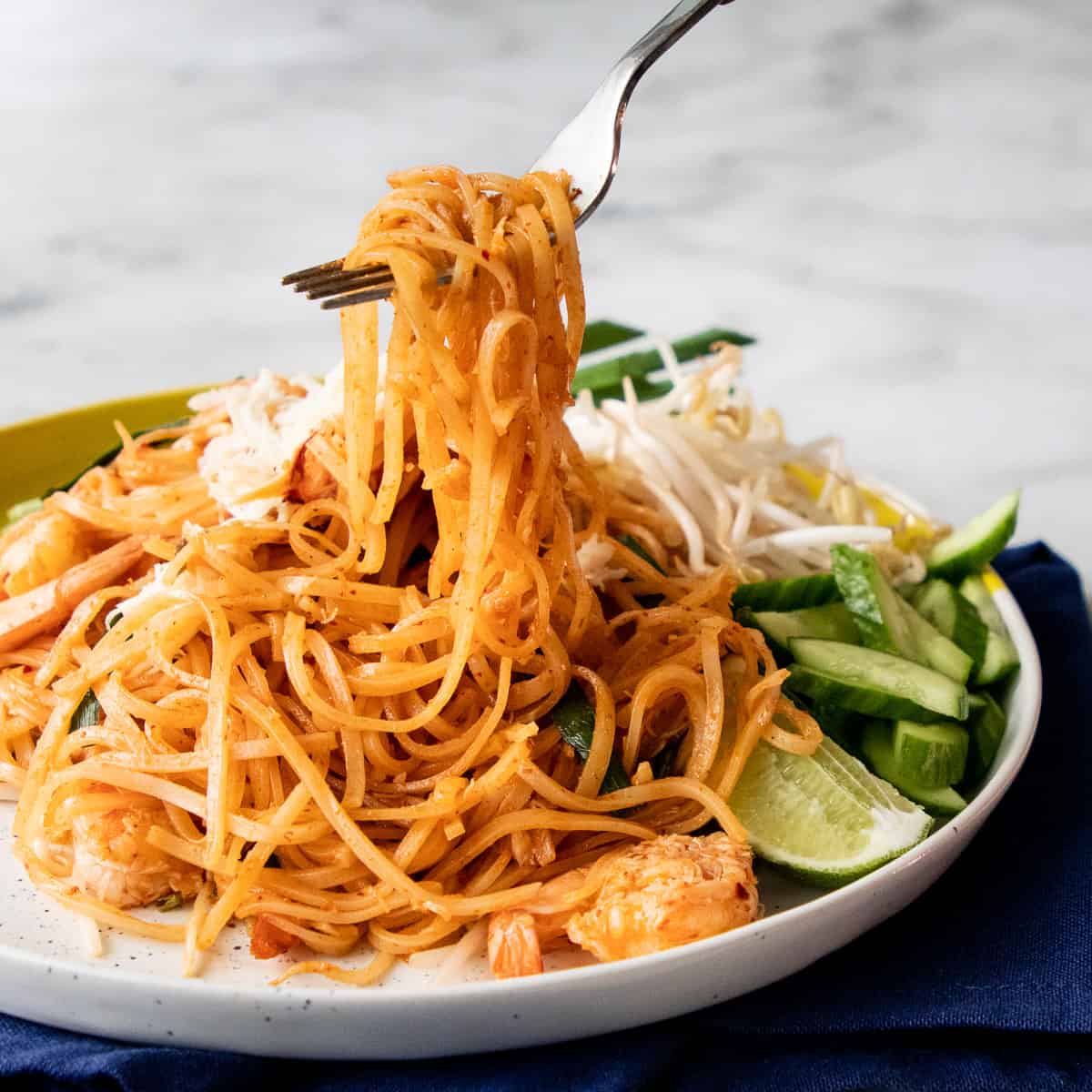
Want to save this recipe?
What Is Sen Chan Pad Pu?
This dish is what I like to call pad thai's easier cousin. It's a rice noodle stir fry with that same sweet-salty-sour flavour profile as pad thai, and it is made typically with crab or shrimp. Sen means noodles, and chan is short for Chanthaburi, a province in Thailand famous for making rice noodles with a chewy texture that are perfect for stir fries. And this dish is Chanthaburi’s local specialty because it features their signature product.
And not just the noodles! Chanthaburi is a coastal city with abundant seafood, so in Thailand you'll see this dish made with seafood only, most commonly crab. (Pad pu means stir fried with crab.) Since crab isn't as accessible for most people, for this recipe I'll show you how to work with both shrimp and crab.
Sen Chan Pad Pu vs. Pad Thai
On the surface the two dishes look similar - sen chan pad pu looks kinda like an orange pad thai. Indeed the two dishes share most of the core ingredients: noodles, tamarind, fish sauce, palm sugar, bean sprouts and garlic chives. But sen chan pad pu is flavoured with chili paste, hence the orange colour, and doesn't have any eggs, tofu, peanuts, preserved radish or dried shrimp.
Because it's made with fewer ingredients sen chan pad pu is easier than pad thai, and I find it to be totally doable on a weeknight. Side note: you can also make regular pad thai weeknight friendly by making the sauce and doing some prep work up front, and I share how to make that happen in my post on how to make pad thai in 5 minutes!
PS. On the subject of orange pad thai, unlike in America, most pad thai in Thailand is brown, not orange (with a few exceptions). American takeout pad thai is often orange because restaurants like to add ketchup or paprika to make the colour more vibrant, but this isn't traditional.
Ingredients and Notes
Here are all the ingredients you need and important notes about them. For amounts, see the full recipe card below.
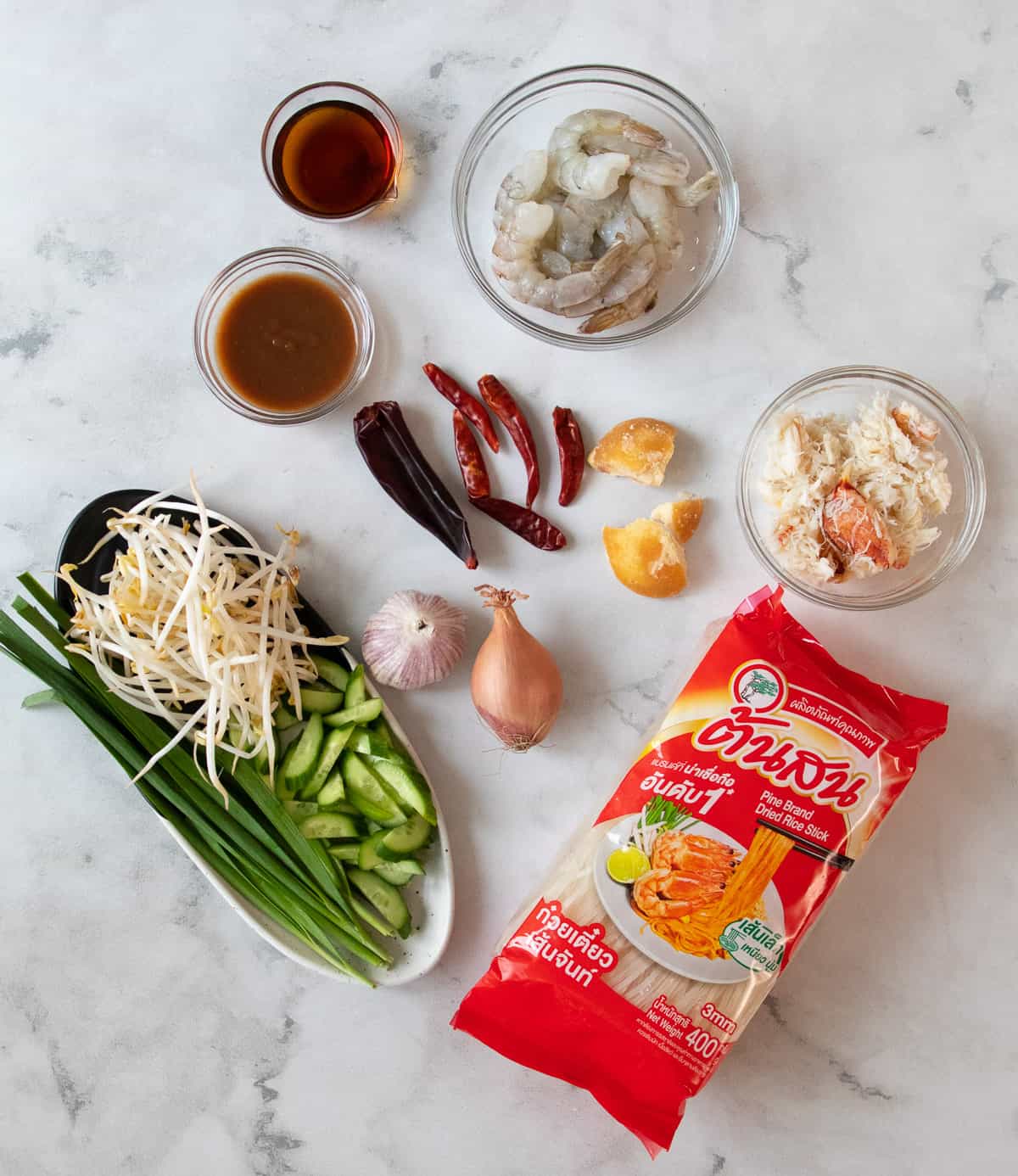
- Dried chilies. This is what gives the iconic orange colour. You can use spicy or mild dried chilies depending on how spicy you want it. I use a combination of 1 small guajillo (mild) and a few smaller spicier dried chilies giving me a nice medium spice level, but feel free to adjust this ratio.
- Garlic
- Shallots
- Palm sugar. Palm sugar adds complexity to the sweetness. See my post all about palm sugar here if you want to learn more about it. You can also sub light brown sugar.
- Tamarind paste. This is what gives sourness to the noodles. Make sure you buy Thai tamarind paste (aka tamarind concentrate) that is a pourable brown liquid, not Indian tamarind which is much more concentrated. You can also make tamarind paste from pulp quite easily!
- Fish sauce. It's important to use good quality fish sauce. See more about how to choose good fish sauce here.
- Shrimp and/or crabmeat. If you have crabmeat, you'll be making the "original" version, but shrimp also work just as well!
- Rice noodles. I'm using Pine Brand (our sponsor!) which has great chewy texture because of the added tapioca starch. If using other brands, make sure you get one that is 3mm wide (⅛ inch) for the right size!
- Bean sprouts
- Garlic chives
- Cucumber. This is served on the side to help lighten the dish. It's quite important!
- Lime wedge for serving. This is optional, depends on how sour your tamarind is. I find that if you're using homemade tamarind paste, the acidity is quite strong and the lime isn't necessary, but it's always good to have on hand just in case you want that extra zing.
How to Make
Here's a bird's eye view of the process, if this is your first time I highly recommend watching the full video tutorial. For full instructions and ingredient amounts, see the recipe card below.

- Soak noodles in room temp water until completely pliable and then drain. (30 mins - 1 hour depending on the brand, more on this below.)
- Remove seeds from the dried chilies and grind into a powder. Alternatively, soak the chilies in hot water for 30 mins until rehydrated, then pound into a paste in a mortar and pestle.
- Pound garlic into a paste in a mortar and pestle, then add chopped shallots and the ground chilies and pound into a rough paste.
- The paste can be made in advance and kept in the fridge for a few days or frozen.

- Saute the chili paste in oil for about a minute or so over medium heat.
- Add the palm sugar and stir until mostly dissolved.
- Add the water, tamarind paste and fish sauce and bring the sauce to a boil.
- Add the shrimp and cook until done, then off heat and remove the shrimp.

- Bring the sauce back to a boil over medium high heat and add the noodles.
- Keep tossing until the noodles absorb all of the sauce, then taste, and if the noodles are too chewy, add a splash of water and keep cooking until done.
- Add the shrimp, crabmeat (if using), garlic chives and bean sprouts and toss just until the bean sprouts are wilted.
- Plate and serve with chopped cucumber, extra bean sprouts and a wedge of lime. Top with more crabmeat for garnish. Enjoy!
Tips and Shortcuts for Soaking Noodles
One of the keys to success in stir frying rice noodles is properly soaking the noodles. Here are some tips:
- To check if noodles are done soaking, lift the noodles up and they should droop completely and have lost all kinks. I soak my noodles in room temp water because it results in the most even hydration and the lowest risk of over-soaking.
- The warmer the water temperature, the shorter the soaking time, so as a shortcut, you can use warm or even hot water, but you have to drain the noodles promptly or they will over-soak and become mushy after cooking.
- It is possible to over-soak noodles in any temperature water, but in room temp water, you have a big buffer, so just check on them once in a while. If using warm or hot water, they will over-soak quickly so keep an eye on them.
- In the case of absolute emergency, i.e. you forgot to soak the noodles, you can soak them in hot off the boil water for exactly 3 minutes (set a timer!) and drain them immediately. I have only tried this with Erawan brand noodles size M (3mm), and timing may vary if using other brands. I don't do this regularly because the risk of over-soaking is high.
Advance Prep Tips
Here are a few things you can do in advance to make this dish even faster to make!
- Soak the noodles in advance, then drain well and keep in the fridge. I rest the drained noodles on a kitchen towel briefly before storing to absorb excess water because you don't want any pooling liquid in the container or they will over-soak in the fridge. They should last in the fridge for up to a week.
- Make the paste in advance. You can keep the chili paste for up to a week in the fridge or freeze it indefinitely.
- Make the sauce in advance. Take it a step further and make the sauce! Saute the paste, then add the palm sugar, tamarind paste, fish sauce and water. Keep this in the fridge and it should last you a couple of weeks. You can make the sauce in bulk, but remember to measure the volume of the sauce once finished and make a note to yourself how much sauce you need per batch.
Storage and Reheating
Like pad thai, rice noodles stir fries in general do not reheat well. This is because the noodles continue to absorb moisture in the fridge, so when you reheat, the noodles will be softer than they were when fresh, and after a few days, they might even be mushy.
This is not a big deal if you have leftovers and you want to eat it the next day. It'll still taste great despite the not-as-chewy texture. But I don't recommend making this as meal prep for your lunch for the week! For that, I suggest trying my glass noodle pad thai which reheats much better.
To reheat, you can microwave or saute it in a non-stick skillet. Make sure to reheat the rice noodles until steaming hot or they will not be soft and may be a bit crunchy and rather unpleasant.
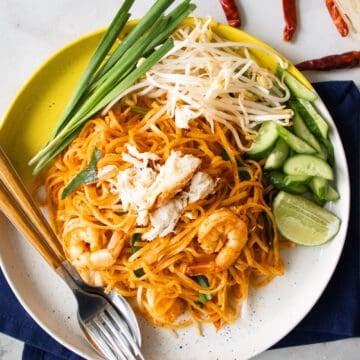
Easier Weeknight Pad Thai (Sen Chan Pad Pu)
Equipment
- wok or large nonstick skillet
- Coffee grinder optional
Ingredients
- 6 oz dry rice noodles, 3 mm wide
- 0.3 oz dried chilies , (see note 1)
- 2 cloves garlic
- 3 Tablespoons finely chopped shallots
- 2 Tablespoons neutral oil
- 1.6 oz palm sugar, about 3½ tablespoons packed (or sub brown sugar), finely chopped (~3½ Tbsp)
- ⅓ cup water
- 3 Tablespoons Thai tamarind paste , (see note 2)
- 2½ Tablespoons fish sauce
- 10-12 medium size shrimp, peeled and deveined
- 3.5 oz crab meat , optional
- 1½ cup 85 g beansprouts, plus extra for serving
- 4 stalks garlic chives, 2-inch pieces, plus extra for garnish
- 2 baby cucumbers, halved and sliced, or sub English cucumber
- Lime wedges for serving, (see note 3)
Want to save this recipe?
Notes
FULL VIDEO TUTORIAL
All my recipes come with step-by-step video tutorials with extra tips not mentioned in the blog post, so make sure you watch the video to ensure success. If you enjoy them, consider subscribing to the YouTube Channel to not miss an episode. Thank you!
Subscribe to my YouTube ChannelInstructions
- Soak the noodles in room temperature (not cold) water for 30 mins - 1 hour. Timing will vary between brands and temperature of your water. Check doneness by lifting the noodles up with your fingers and they should be completely limp, have no resistance to gravity, and no longer retain their old shape. If you’re in a rush, you can use warm water and it’ll shorten the soaking time, but be careful not to over-soak (see more noodle soaking tips in the blog post above).6 oz dry rice noodles
- Remove seeds from the chilies by using scissors to cut them into chunks and allowing the seeds to pour out. No need to remove every last seed, whatever comes out is fine. Grind the chilies in a coffee grinder into a fine powder. If you don’t have a coffee grinder, you can cut and soak the chilies in room temp water until rehydrated (about 30 mins), then pound in a mortar and pestle into a paste.0.3 oz dried chilies
- In a mortar and pestle, pound the garlic into a paste, then add the shallots and the ground chilies and pound into a rough paste.2 cloves garlic, 3 Tablespoons finely chopped shallots
- Combine the tamarind paste with the fish sauce and ⅓ cup (80 ml) of water and stir to combine.3 Tablespoons Thai tamarind paste, 2½ Tablespoons fish sauce, ⅓ cup water
- Before you turn the stove on, keep a cup of water nearby. Heat a wok or a large non-stick skillet over medium heat. Once hot, add the oil and the chili paste and cook for about 1 minute, stirring constantly.2 Tablespoons neutral oil
- Add the palm sugar and cook until mostly dissolved, about 30 seconds. Then add the tamarind sauce mixture and bring to a boil.1.6 oz palm sugar, about 3½ tablespoons packed (or sub brown sugar)
- Add the shrimp (if using) and cook them in sauce for 1 minute, flipping them halfway through, just until they are done. Turn off the heat and remove the shrimp, leaving all the sauce behind.10-12 medium size shrimp
- Turn the heat back on medium high and add the soaked noodles. Keep tossing the noodles with tongs until all the sauce has been absorbed. Turn off the heat and taste the noodles, and if they are still too chewy, add a splash of water, and turn the heat back on and keep cooking until all the additional water has all been absorbed. Keep checking and adding water until the noodles are cooked through but still maintain a slight chew. (There are many factors that affect how much water you need to add, so it's okay if you end up adding a lot more or none at all, as long as the noodles are properly cooked.)
- Once the noodles are cooked, add the beansprouts, garlic chives, cooked shrimp and most of the crab (if using), leaving a bit of crab behind for garnish. Turn off the heat and toss everything until just until the beansprouts are wilted.1½ cup 85 g beansprouts, plus extra for serving, 4 stalks garlic chives, 3.5 oz crab meat
- Plate the noodles, top with more crab (if using), more beansprouts, cucumber, and a lime wedge on the side.2 baby cucumbers, Lime wedges for serving

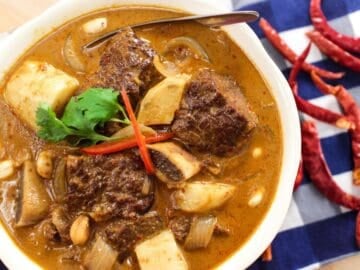

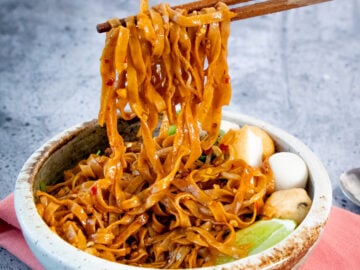

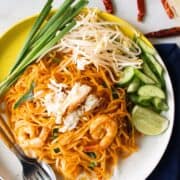
Lisa says
Delicious, love your channel & your recipes! Thank you!
Zeljka says
Thank you for sharing such delicious recipe and particularly how to make Pad Thai.
Every time I made the noodles, they were too wet and then the Pad Thai does not look appealing and it lacks flavour. Plus I was using home bought sauces from Asian Grocers that just did not meet the restaurant quality or taste. Your recipe is so simple and my family loved the flavour plus it looked a lot better than my previous attempts.
Once again a big thank you.
Claudia says
I LOVE this recipe! Super easy and super fast once the noodles are done soaking. Thank you for the recipe and tips for a delicious dish!
Brad says
Looks tasty! I wonder: this chili paste + sauce seems to have a lot in common with nam prik pao. Might there be a way to use nam prik pao as a "base" or shortcut for this dish?
web says
Need access to your sponsor and its noodles. None found here.
Pailin Chongchitnant says
Right now there's no online sources for the noodles, unfortunately! They can be found in stores in Australia and Thailand, but they will be available in other countries soon. But you can substitute another brand of rice noodles using the same recipe without any modification!